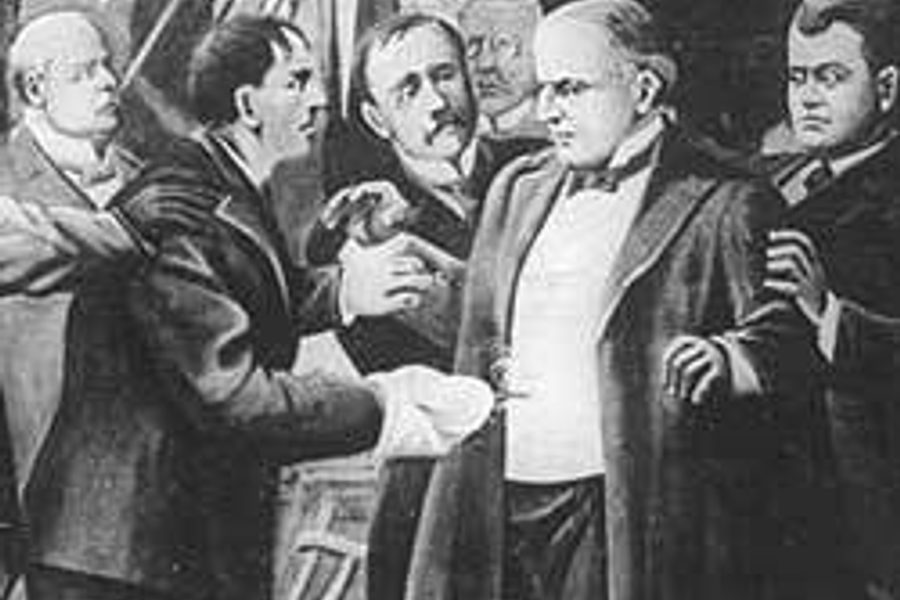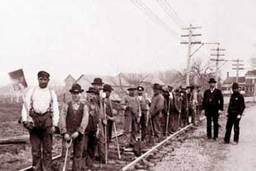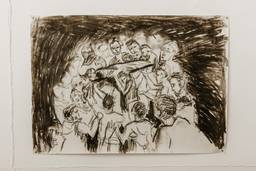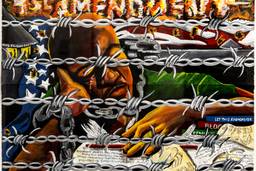
On September 6, 1901, President William McKinley visited Buffalo, N.Y., for the Pan-American Exposition, a celebration of the United States’ emergence as an industrial and imperial power. Around 4 p.m., McKinley entered the Temple of Music, a building on the fairgrounds, to greet the public. A few minutes later, Secret Service agent George Foster noticed a “dark complexioned man with a black moustache” in the crowd near the president. As Foster’s eyes settled on the black man—“I didn’t like his general appearance,” the agent later explained—another visitor stepped forward from the crowd. Pale and slender, he held a pistol concealed under a white bandage. He fired two shots into the president from close range. One week later, McKinley died.
In Murdering McKinley, historian Eric Rauchway argues that the assassination of William McKinley by a self-described anarchist, Leon Czoglosz, had far-reaching social consequences. In coming to terms with this national trauma, American opinion-makers faced up to some of the consequences of the country’s rapid industrialization: inequalities of wealth, overcrowding of cities, massive immigration. And they developed new public policies, from regulations of industry to school reforms, as a result.
The authorities “tried the assassin, executed him, dropped him in a grave, and poured sulfuric acid over his body,” Rauchway writes, “but they could not forget the brutal lesson he had taught.” In McKinley’s violent death, a new political era—what Rauchway calls Theodore Roosevelt’s America—was born.
A former congressman and governor of Ohio, William McKinley embodied the social and political conservatism of the Republican Party at the end of the 19th century. A longtime ally of big business, he made his name in politics by sponsoring protective tariffs and defending gold currency against populist agitation for a looser money supply. In 1896, he campaigned for president from his front porch while his Democratic opponent, William Jennings Bryan, stormed about the country. In his first term, McKinley delivered for his supporters in finance and industry. An economic boom boosted profits and the Spanish-American War gave the United States new imperial possessions, with new markets and natural resources to exploit. In 1900, McKinley became the first U.S. president in 28 years to win a consecutive term.
Despite political success, McKinley had critics. Industrialization spawned great fortunes, but it also created a massive class of low-paid workers. In the 1880s and 1900s workers launched a series of violent strikes and a radical labor movement emerged. McKinley was anything but neutral during these conflicts, and his firm alliance with bankers and industrialists generated enemies. The cartoonist Homer Davenport drew McKinley as a marionette being manipulated by men who wore dollar signs on their suits.
After Kentucky governor-elect William Goebel was murdered in 1900, Ambrose Bierce expressed the national mood in eerie verse: “The bullet that pierced Goebel’s breast / Can not be found in all the West; / Good reason, it is speeding here / To stretch McKinley on his bier.”
When the bullet came, McKinley’s friends and allies denied that any rational motive could account for it. The new president, Theodore Roosevelt, insisted that anarchism “is no more an expression of ‘social discontent’ than wife-beating or pick-pocketing.” Its advocates, he said, have “perverted instincts” and prefer “confusion and chaos to the most beneficent form of social order.” McKinley was not a captain of industry but a lifelong public servant, he added. Why target him?
In Czoglosz’s Buffalo courtroom, lawyers followed Roosevelt’s lead. Rather than discuss any motives Czoglosz might have had, they argued whether the defendant was responsible for his delusions. Court-appointed attorney Loran L. Lewis tried to save Czoglosz’s life with an insanity defense. Lewis noted that Czoglosz lacked “any animosity against our President … any personal motive” and wondered, “[C]ould a man, with a sane mind, perform such an act?”
The prosecution countered that Czoglosz was “a product of anarchism, sane and responsible.” Those became the two poles of respectable political debate. The most prominent exception was the assassin himself, who remained unrepentant. “McKinley was going around the country shouting about prosperity when there was no prosperity for the poor man,” he explained. By shooting the president, he insisted, “I only done my duty.”
Although Roosevelt never reversed his opinions about anarchists, he began to endorse, by implication, a contradictory explanation of the killing—that Czoglosz’s deed was evidence that something was wrong. Even as Roosevelt mocked the idea that one could pin McKinley’s assassination on “social discontent,” he immediately asked Congress to address the “very serious social problems” stemming from “tremendous and highly complex industrial development.” He called for government regulation of banking, currency and the railroads, among other reforms.
According to Rauchway, Roosevelt’s mixed feelings get at the complicated nature of reform politics in the early 20th century. Rather than an expression of class identity or political interest, progressivism was “a belief about human nature and modern environment, as revealed in one’s own experience.” It acknowledged that the complexity of life under industrial capitalism made it harder for individuals to control their fate. In response, progressives tried to build a healthy social environment—clean streets, open spaces, decent schools—in American cities. They shared the part of the anarchist critique that suggested “a sick environment develops sick inhabitants.” But they rejected the anarchist implications of the argument—that industrial capitalism must therefore be destroyed.
Rauchway makes this argument through a herky-jerky, out-of-order narrative, which begins at the Pan-American Exposition, travels backward into Czoglosz’s youth and eventually jumps forward to an attempted assassination of Theodore Roosevelt in 1912. In addition to McKinley, Roosevelt, Czoglosz and his lawyers, Rauchway introduces readers to a variety of prominent and obscure Americans who were dragged into press accounts of the assassination story. National figures Jane Addams, Jacob Riis and Emma Goldman appear, as does James Parker, a Buffalo waiter briefly known as the “Negro who saved McKinley” for helping to wrestle Czoglosz to the ground.
In eager, excitable prose, Rauchway identifies an important truth: Dramatic acts of public violence can have substantial if unpredictable public consequences. That said, the connection between McKinley’s assassination and political change is not completely evident. There were other reasons for reform—labor unrest, realignment of political parties, consequences of empire, social activism and business interest. Given that Rauchway often alludes to the present by describing a “war on anarchism” and referring to potential bomb-throwers as “evildoers,” I don’t mind using the irritating current parlance: Did the assassination “change everything”? Or did it simply provide a Rorschach test of beliefs?
For a few people, at least, Rauchway shows how the McKinley assassination could mean a great deal. Besides Roosevelt, the central progressive in this book is Lloyd Vernon Briggs, a young Boston doctor fascinated with the matter of Czoglosz’s sanity. Briggs traveled to Buffalo and Cleveland to track down anyone who had known the killer. Czoglosz, he eventually discovered, was born in Michigan to Polish-Catholic immigrants from Prussia. Never married, he worked as a glassmaker, in a wire mill and as a handyman on a family farm. While working at the wire mill, he became involved in organized labor and lost his job after a failed strike. He later joined, but eventually became disillusioned with, a Bellamyite socialist group. He traveled to Chicago, where he met Emma Goldman but failed to ingratiate himself with her circle of anarchist intellectuals. (They rebuffed him because he “asked foolish questions” and seemed like a spy.) Alienated from the industrial economy and the few open alternatives, he made his way to Buffalo.
Briggs concluded that Czoglosz had to be insane, blaming a bad social environment for creating the resentment that fed his radicalism. But he argued that Czoglosz should have nevertheless developed an awareness of other people’s rights that would have prevented him from pulling the trigger.
Rauchway comes to a fascinating conclusion of his own, which need not be divulged here. But he argues the question of the assassin’s mental capacity is, finally, beside the point. Whatever the killer’s mental state, the act of shooting McKinley followed a brutal logic; it was cruel for its rationality, not for its senselessness.
By understanding the horrible logic of political violence, one can find a path between the dead ends of incomprehension and rationalization. That path was as hard to identify in Roosevelt’s America as it seems to be today.
In Murdering McKinley, historian Eric Rauchway argues that the assassination of William McKinley by a self-described anarchist, Leon Czoglosz, had far-reaching social consequences. In coming to terms with this national trauma, American opinion-makers faced up to some of the consequences of the country’s rapid industrialization: inequalities of wealth, overcrowding of cities, massive immigration. And they developed new public policies, from regulations of industry to school reforms, as a result.
The authorities “tried the assassin, executed him, dropped him in a grave, and poured sulfuric acid over his body,” Rauchway writes, “but they could not forget the brutal lesson he had taught.” In McKinley’s violent death, a new political era—what Rauchway calls Theodore Roosevelt’s America—was born.
A former congressman and governor of Ohio, William McKinley embodied the social and political conservatism of the Republican Party at the end of the 19th century. A longtime ally of big business, he made his name in politics by sponsoring protective tariffs and defending gold currency against populist agitation for a looser money supply. In 1896, he campaigned for president from his front porch while his Democratic opponent, William Jennings Bryan, stormed about the country. In his first term, McKinley delivered for his supporters in finance and industry. An economic boom boosted profits and the Spanish-American War gave the United States new imperial possessions, with new markets and natural resources to exploit. In 1900, McKinley became the first U.S. president in 28 years to win a consecutive term.
Despite political success, McKinley had critics. Industrialization spawned great fortunes, but it also created a massive class of low-paid workers. In the 1880s and 1900s workers launched a series of violent strikes and a radical labor movement emerged. McKinley was anything but neutral during these conflicts, and his firm alliance with bankers and industrialists generated enemies. The cartoonist Homer Davenport drew McKinley as a marionette being manipulated by men who wore dollar signs on their suits.
After Kentucky governor-elect William Goebel was murdered in 1900, Ambrose Bierce expressed the national mood in eerie verse: “The bullet that pierced Goebel’s breast / Can not be found in all the West; / Good reason, it is speeding here / To stretch McKinley on his bier.”
When the bullet came, McKinley’s friends and allies denied that any rational motive could account for it. The new president, Theodore Roosevelt, insisted that anarchism “is no more an expression of ‘social discontent’ than wife-beating or pick-pocketing.” Its advocates, he said, have “perverted instincts” and prefer “confusion and chaos to the most beneficent form of social order.” McKinley was not a captain of industry but a lifelong public servant, he added. Why target him?
In Czoglosz’s Buffalo courtroom, lawyers followed Roosevelt’s lead. Rather than discuss any motives Czoglosz might have had, they argued whether the defendant was responsible for his delusions. Court-appointed attorney Loran L. Lewis tried to save Czoglosz’s life with an insanity defense. Lewis noted that Czoglosz lacked “any animosity against our President … any personal motive” and wondered, “[C]ould a man, with a sane mind, perform such an act?”
The prosecution countered that Czoglosz was “a product of anarchism, sane and responsible.” Those became the two poles of respectable political debate. The most prominent exception was the assassin himself, who remained unrepentant. “McKinley was going around the country shouting about prosperity when there was no prosperity for the poor man,” he explained. By shooting the president, he insisted, “I only done my duty.”
Although Roosevelt never reversed his opinions about anarchists, he began to endorse, by implication, a contradictory explanation of the killing—that Czoglosz’s deed was evidence that something was wrong. Even as Roosevelt mocked the idea that one could pin McKinley’s assassination on “social discontent,” he immediately asked Congress to address the “very serious social problems” stemming from “tremendous and highly complex industrial development.” He called for government regulation of banking, currency and the railroads, among other reforms.
According to Rauchway, Roosevelt’s mixed feelings get at the complicated nature of reform politics in the early 20th century. Rather than an expression of class identity or political interest, progressivism was “a belief about human nature and modern environment, as revealed in one’s own experience.” It acknowledged that the complexity of life under industrial capitalism made it harder for individuals to control their fate. In response, progressives tried to build a healthy social environment—clean streets, open spaces, decent schools—in American cities. They shared the part of the anarchist critique that suggested “a sick environment develops sick inhabitants.” But they rejected the anarchist implications of the argument—that industrial capitalism must therefore be destroyed.
Rauchway makes this argument through a herky-jerky, out-of-order narrative, which begins at the Pan-American Exposition, travels backward into Czoglosz’s youth and eventually jumps forward to an attempted assassination of Theodore Roosevelt in 1912. In addition to McKinley, Roosevelt, Czoglosz and his lawyers, Rauchway introduces readers to a variety of prominent and obscure Americans who were dragged into press accounts of the assassination story. National figures Jane Addams, Jacob Riis and Emma Goldman appear, as does James Parker, a Buffalo waiter briefly known as the “Negro who saved McKinley” for helping to wrestle Czoglosz to the ground.
In eager, excitable prose, Rauchway identifies an important truth: Dramatic acts of public violence can have substantial if unpredictable public consequences. That said, the connection between McKinley’s assassination and political change is not completely evident. There were other reasons for reform—labor unrest, realignment of political parties, consequences of empire, social activism and business interest. Given that Rauchway often alludes to the present by describing a “war on anarchism” and referring to potential bomb-throwers as “evildoers,” I don’t mind using the irritating current parlance: Did the assassination “change everything”? Or did it simply provide a Rorschach test of beliefs?
For a few people, at least, Rauchway shows how the McKinley assassination could mean a great deal. Besides Roosevelt, the central progressive in this book is Lloyd Vernon Briggs, a young Boston doctor fascinated with the matter of Czoglosz’s sanity. Briggs traveled to Buffalo and Cleveland to track down anyone who had known the killer. Czoglosz, he eventually discovered, was born in Michigan to Polish-Catholic immigrants from Prussia. Never married, he worked as a glassmaker, in a wire mill and as a handyman on a family farm. While working at the wire mill, he became involved in organized labor and lost his job after a failed strike. He later joined, but eventually became disillusioned with, a Bellamyite socialist group. He traveled to Chicago, where he met Emma Goldman but failed to ingratiate himself with her circle of anarchist intellectuals. (They rebuffed him because he “asked foolish questions” and seemed like a spy.) Alienated from the industrial economy and the few open alternatives, he made his way to Buffalo.
Briggs concluded that Czoglosz had to be insane, blaming a bad social environment for creating the resentment that fed his radicalism. But he argued that Czoglosz should have nevertheless developed an awareness of other people’s rights that would have prevented him from pulling the trigger.
Rauchway comes to a fascinating conclusion of his own, which need not be divulged here. But he argues the question of the assassin’s mental capacity is, finally, beside the point. Whatever the killer’s mental state, the act of shooting McKinley followed a brutal logic; it was cruel for its rationality, not for its senselessness.
By understanding the horrible logic of political violence, one can find a path between the dead ends of incomprehension and rationalization. That path was as hard to identify in Roosevelt’s America as it seems to be today.
Jefferson Decker is co-editor of A Way Out: America’s Ghettos and the Legacy of Racism (Princeton University Press) and is a doctoral candidate in American history at Columbia University.






